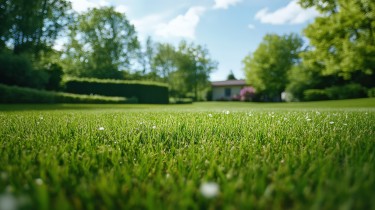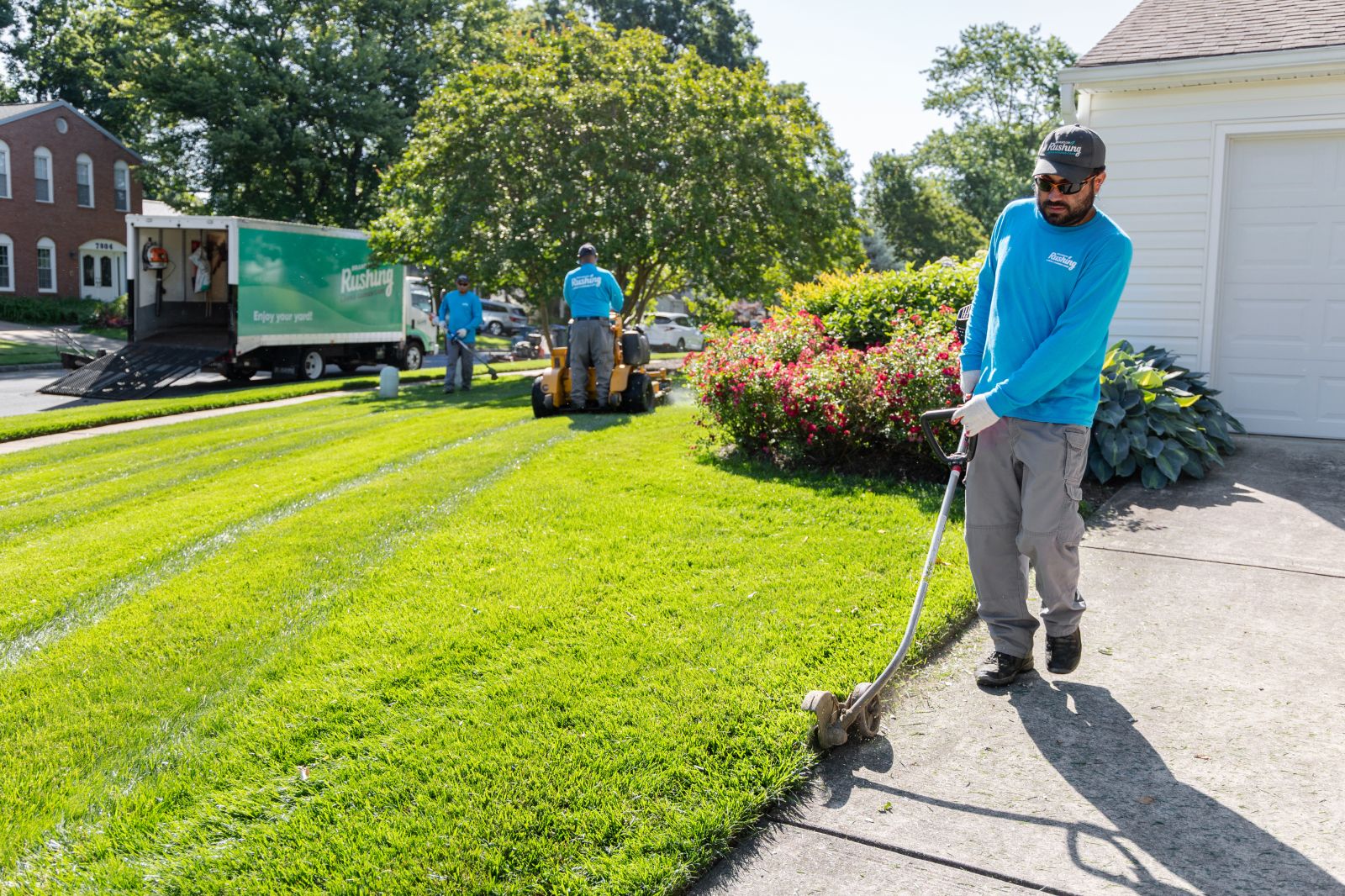Proper mowing helps your lawn become thick and healthy by promoting strong root development and keeping weeds at bay. But if you want your lawn to look well-manicured and professionally cared for, you should take the time to edge it.
It’s impossible for lawn mowers, especially large commercial mowers, to reach all the spots in your yard. Now, most people will reach for a string trimmer — also known as a weed whacker — to finish those areas, but string trimming is not the same as edging. In this post we’ll explain the difference between the two, why edging is important and how to edge your lawn properly. Let’s get started!
When to use a string trimmer
Most people have used a string trimmer to take care of grass the mower can’t reach. It uses a rapidly rotating nylon string to cut through and trim grass and weeds. The cutting line is advanced by tapping the trimmer head against the ground or using a feeding mechanism, ensuring a continuous supply of fresh line during operation. Here are some instances when a string trimmer would be effective.
- Edging — String trimmers can trim grass and weeds that grow right up to the edges of buildings and other hardscapes, providing a neat and polished appearance.
- Trimming tight spaces — Their compact size and maneuverability allow string trimmers to trim the grass in tight or hard-to-reach areas.
- Slopes and uneven landscapes — A string trimmer is a more suitable tool in areas that are uneven or steeply sloped. Its lightweight design and flexible cutting head make it easier to control and safer to operate on challenging landscapes. For example, a zero-turn mower shouldn’t mow on hills steeper than 15 degrees.
- Spot trimming — Sometimes it's necessary to touch-up a small area or trim overgrown grass or weeds. A string trimmer can do the job quickly without having to mow the entire area.
- Weed control — String trimmers are effective tools for managing and controlling weeds, especially if you’re dealing with large areas and you don’t have the time to weed by hand.
If you have a steady hand and a good eye, you can create an edge around garden beds, patios and walkways. However, it won’t give you the straight, clean lines you’re looking for. For that, you’ll need an edger.
When to use an edger
An edger is a unique tool designed to create straight, clean lines. Instead of a nylon string, it uses a rotating blade to dig down into the dirt, creating a small trench that offers a clean transition from your lawn to other landscape features. Here are some instances when an edger would be effective.
- Edging borders — A lawn edger is ideal for creating clean and defined borders between the lawn and adjacent surfaces such as sidewalks, driveways, pathways, or garden beds.
- Cutting straight, precise edges — If you like the look of straight, crisp lines along the edges of your lawn, you have to use a lawn edger. A string trimmer isn’t precise enough to give you these crisp edges.
- Keeping your grass on the lawn — When the grass along the edges of the lawn starts encroaching onto hardscapes or garden beds, a lawn edger can quickly trim and remove the excess growth. If left unchecked, grass can completely take over and bury your sidewalk.
- Managing curved edges — A lawn edger is particularly useful when dealing with curved or irregular shapes. Its design allows for more precise control, making it easy for you to maintain consistent curves or unique shapes along the edges.
Do you really need to edge your lawn?
Edging your lawn offers several benefits that contribute to its overall health and appearance and is one of the tools in every landscaper’s toolbox. Here are some ways edging benefits your lawn.
- Edged lawns always look neat and tidy — Edging creates clean, crisp lines that make your lawn look visually pleasing and well-groomed, improving your home’s curb appeal without spending a lot of money.
- Reduce the time spent maintaining edges — Creating a physical barrier that prevents grass from spreading into flower beds, mulched areas and hardscapes reduces the need for constant trimming, weeding and maintenance.
- Make lawn care more efficient — Edging eliminates the need to manually trim grass along the edges, saving time and effort during regular lawn maintenance. It also reduces the risk of damaging your flowers when using a string trimmer near your garden bed.
- Healthy growth and root development — Clear edges created by edging help redirect the growth of grass roots, allowing your turf to enjoy more space and nutrients. This promotes deeper growth and stronger root systems, making your lawn healthier and more resistance to drought and stress.
- Better weed control — Edging creates a physical barrier that helps stop weeds from spreading into the lawn.
- Improved water management — Well-defined edges help prevent water from pooling or running off your lawn unevenly, ensuring it receives adequate moisture while reducing the risk of overwatering or soil erosion.
- Keep gravel and loose stone in place — Landscape edging helps define pathways and walkways made of loose material, such as gravel or mulch, securely in place.
So should you edge your lawn? The lawn care professionals and Brandon Rushing all give a resounding “Yes!”. If you don’t want to edge your lawn, you can always install a mowing strip to create a base suitable for the wheels of a lawnmower.
How to use an edger
To use an edger effectively, follow these general steps.
- Clear the area — Remove any debris, rocks, or obstacles that might interfere with the edger.
- Adjust the edger — Adjust the cutting depth according to the results you’re looking for and the condition of your lawn. Refer to the manufacturer's instructions for instructions on how to adjust your specific edger.
- Start at the right spot — For best results, start near a natural boundary like a sidewalk or driveway.
- Align the edger properly — Position the edger so the cutting blade is touching the ground and aligned with the edge, keeping a firm grip on the handle.
- Begin edging your lawn — Following the manufacturer's instructions, start the engine and activate the power. If using a manual edger, use the footrest to drive the blade into the ground. Slowly walk forward, guiding the edger along the desired edge and allowing the blade to do the work. Maintain a steady pace and even pressure to ensure an even cut.
- Clean up — After edging the perimeter of your lawn, use a broom or blower to remove any loose debris or grass clippings from the edged area. Clean the edger and store it in a safe and secure location.
We’re here to help!
We know that keeping your lawn and garden looking great takes time... time you might not have. We want you to feel proud of your lawn and gardens and have time to enjoy them! We’ve made it our mission to care for you and your property, and our horticultural experts have developed a proven 12-month program to keep both your lawn and gardens healthy.
If you’re interested in learning more about our lawn and garden care, book a consultation with one of our lawn and garden care experts.




